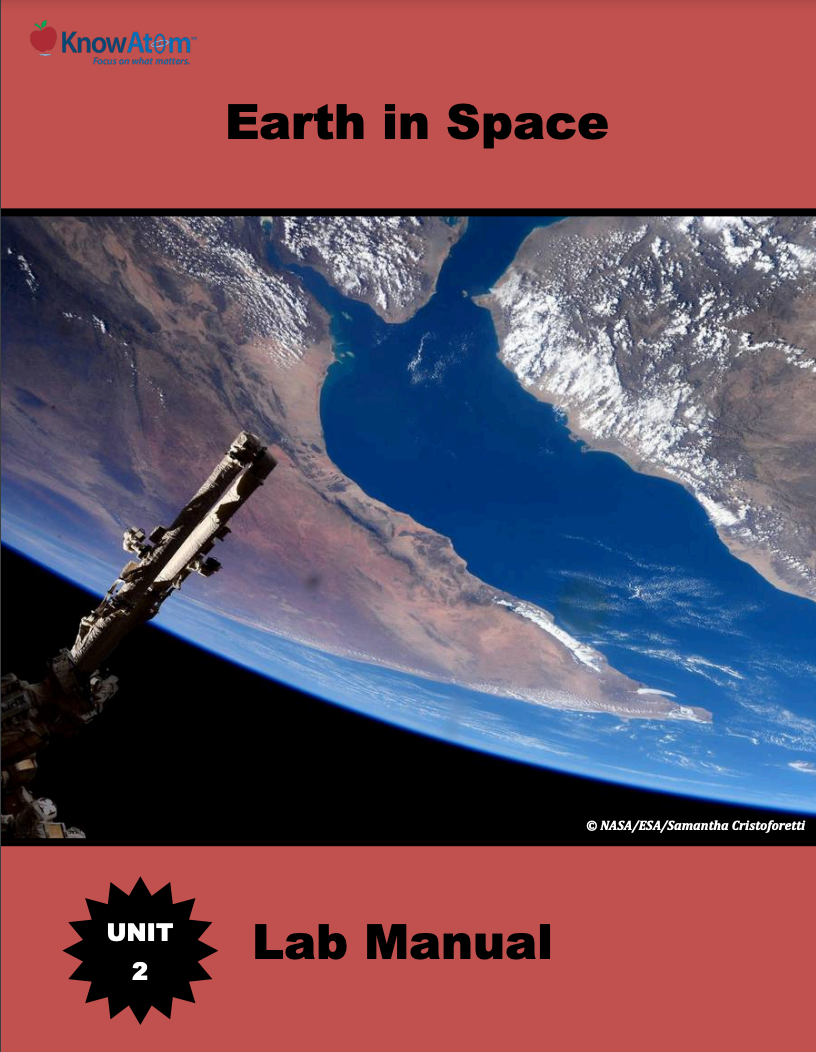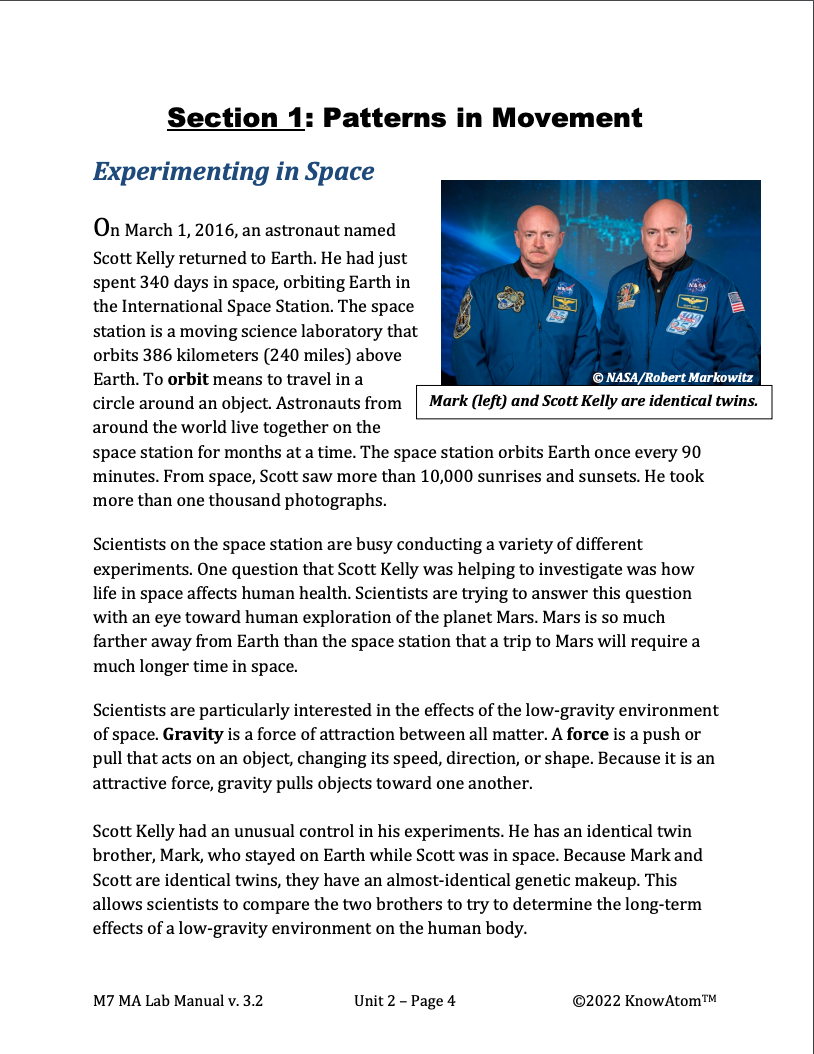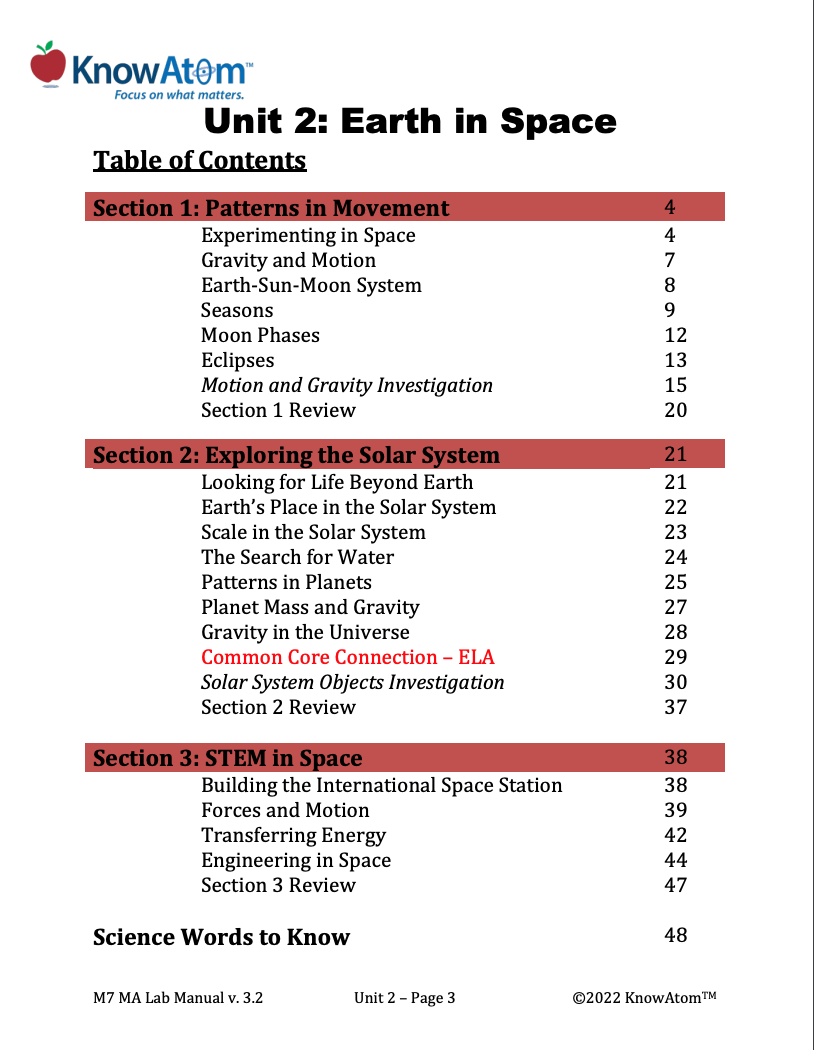In this lesson, students apply what they know about forces and motion to design a technology that solves the problem of collisions between meteoroids and spacecraft.
In this unit, students apply what they have previously learned about forces, motion, and matter to the solar system, focusing on the phenomena of gravity’s role in the universe. In this lesson, students engineer a solution to collisions between moving objects in space. This page is a high-level extract of this lesson.
Science background provides teachers with more in-depth information about the phenomena students explore. Below is an excerpt of the science background on engineering solutions.
If a paint fleck hits the International Space Station, the force of the collision transfers some of the kinetic energy to the space station. This transfer of energy is what causes damage, such as denting a window.
If a more massive piece of space debris were to collide with the space station, it would cause more damage than a paint fleck. This is because a more massive object moving at a certain speed has more kinetic energy than a less massive object moving at the same speed. As a result, the massive object will apply a greater force in a collision, transferring more kinetic energy to the space station.
Engineers spend a lot of time thinking about how to protect the International Space Station and other spacecraft from space debris. One way that engineers protect spacecraft is with shields, which are physical structures that prevent space debris from reaching the spacecraft and causing damage. In order to design shields, engineers need to apply what they know about forces, energy transfer, and motion.
Similar to how scientists follow a scientific process to answer a question, engineers also follow a process. Engineers often follow a process with eight steps that guides them as they create new technologies to solve problems. The engineering process is similar to the scientific process but it differs because each has a different goal. Scientists are trying to answer a question, while engineers are trying to solve a problem.
The engineering process begins with a problem. When engineers are defining a problem, they include the criteria (the needs the solution must meet) and constraints (ways the solution is limited). For example, shields are designed to solve the problem of speeding space debris that can cause serious damage to an object, such as the space station or a spacecraft, in space. In this example, the criteria might be that the shields must be able to withstand the collision force of space debris traveling up to 28,163 kilometers per hour (17,500 mph). Available materials and cost are two common engineering constraints.
Once they have identified the problem, engineers need to research it to find out what is known about the problem. For example, engineers designing a shield need to know that when two objects collide, the force of that collision causes energy to transfer from one object to another. They also need to understand what momentum is. Momentum is the measurement of an object’s mass multiplied by its speed. Before a piece of space debris collides with the space station, it has momentum that depends on its mass and the speed at which it’s moving.
When the piece of space debris comes into contact with the space station, its momentum causes kinetic energy to be transferred to the space station. The more momentum the piece of space debris has, the more energy it will transfer and the more damage it will cause.
However there are ways to reduce the effects of a collision. If an object’s momentum can be slowed down before the collision, the force at impact will cause less damage. An object’s momentum decreases when energy transfers out of it. This goes back to the conservation of energy. Remember that energy is never created or destroyed. This means that if energy is transferred out of an object, it will have less energy to transfer during a collision.
Parachutes are a good research example of how slowing momentum reduces the amount of energy transferred during a collision. Parachutes work by slowing down the momentum of a person falling from the sky. They do this by increasing drag. As the force of gravity pulls the person down, drag acts in the opposite direction of the motion, slowing motion.
The result of this is a much slower movement down to the ground because the person’s momentum has decreased. By the time the person comes into contact with the ground, most of the energy has been transferred out of the system (made up of the parachute and the person).
This is important because at the moment of impact, action-reaction forces will occur. When the person’s feet hit the ground, that person applies a force to the ground. The ground will exert an equal force on the person. It’s better for the person to hit the ground with as little force as possible.
These same concepts have been applied by engineers designing safety features in cars. People in a moving car all have momentum. If the car comes to a sudden stop, the people will keep moving until they are stopped by an outside force because of inertia. Airbags are designed to slow down a person’s momentum gradually, applying action-reaction forces to transfer energy out of the system. As a person’s momentum pushes them into the airbag, air is slowly released out of small holes along the edges of the airbag. By the time the car comes to a complete stop, the airbag should be completely deflated.
In this lesson, students apply what they know about forces and motion to design a technology that solves the problem of collisions between meteoroids and spacecraft.

Prepared hands-on materials, full year grade-specific curriculum, and personalized live professional development designed to support mastery of current state science standards.
Misconception: A continued force is required to keep an object moving.
Fact: According to Newton’s first law, an object in motion will continue moving until acted on by an outside force. It does not need a continued force to keep it moving.
Misconception: Gravity only exists on Earth.
Fact: All matter, both on Earth and in space, has gravity. The sun has the strongest gravity in our solar system, which is why planets orbit it.
Solar System : a collection of planets and other objects that orbit a sun
Engineer : a person who uses scientific knowledge and mathematics to solve problems by creating new technologies
Momentum : the measurement of an object’s mass multiplied by its speed
Prototype : a scaled-down first draft of a technology
Building the International Space Station
The International Space Station is slightly larger than an American football field. It is so large that it had to be built in space. The first piece was launched in 1998, and it wasn’t finished until 2011. However, people began living on it in 2000.
The space station had to be built piece-by-piece in space because there is no rocket powerful enough to launch the entire station into space at one time. The completed space station has a mass of almost 453,592 kilograms (1 million pounds). Scientists and engineers had to send the separate parts of the space station on rockets. It took more than 40 missions to get all of the materials into space and assembled.
Engineers who designed the rockets that launched the parts of the space station into space applied Newton’s three laws of motion:
1. Stationary objects won’t start moving, and moving objects won't stop moving unless the forces pushing or pulling on these objects become unbalanced (the law of inertia).
2. Force = mass times acceleration.
3. For every action, there is an equal and opposite reaction.
Rockets are designed to move because of action-reaction forces. The rocket pushes combustion exhaust downward—the action. This is also called thrust. In reaction, the exhaust pushes the rocket upward.
Because of Newton’s second law, the greater the thrust, the more the rocket will accelerate upwards. Similarly, the more massive the rocket is, the more powerful the thrust will need to be. This is why the International Space Station couldn’t be launched after it was already built. There is no rocket that can produce a powerful enough thrust to get an object that massive into space.
Once the rocket begins to move, it will continue to move until another force acts on it to slow it down or stop it. On Earth, gravity pulls down on the rocket. The rocket also experiences drag as it moves through the air. Remember that drag is a force that transfers motion out of an energy system by causing some of the energy of a moving object to change into heat. Drag acts on an object in the opposite direction as the movement.
Because of this, the rocket must produce enough thrust to counter Earth’s gravity and the air’s drag. The amount of thrust needed depends on the rocket’s mission. If it is to explore Mars, for example, the rocket needs enough thrust to move beyond Earth’s gravitational field entirely. However, rockets heading to the International Space Station need enough thrust to move into space, but not so much that they leave Earth’s gravitational field. With the right amount of force, the rocket can begin to orbit Earth. If the rocket did clear Earth’s gravitational field, it would continue to move in a straight line because of inertia.
Once rockets carrying spacecraft are successfully launched into space, astronauts must be very aware of space debris. More than 500,000 pieces of space debris orbit Earth. Some of the debris is natural, such as meteoroids. However, the most common space debris orbiting Earth comes from human- made sources, including old spacecraft that are no longer in use. These objects travel at speeds up to 28,163 kilometers per hour (17,500 mph).
At those speeds, even tiny paint flecks can damage structures because moving objects have kinetic energy. Whenever two objects come into contact with one another, they exert a force on each other for a short period of time. This is called a collision.
The force of a collision causes energy to transfer from one object to another. The faster an object is moving, the more energy it will transfer. When a moving object hits another object, the force of the collision transfers some of the kinetic energy into the second object, and into other forms of energy, such as sound. This is why collisions often make loud noises. The force can also transfer energy that changes the objects’ motion.



For the interactive activity of this lesson, students figure out how to apply Newton’s third law of motion to design a shield technology for an orbiter to prevent damage from the phenomena of meteoroid collisions in space. First, students consider the criteria and constraints of the problem before they design and build their prototype shield. Then, they test the prototype to analyze how effective it was before they make any needed modifications to their design.
KnowAtom incorporates formative and summative assessments designed to make students thinking visible for deeper student-centered learning.

Standards citation: NGSS Lead States. 2013. Next Generation Science Standards: For States, By States. Washington, DC: The National Academies Press. Neither WestEd nor the lead states and partners that developed the Next Generation Science Standards were involved in the production of this product, and do not endorse it.
